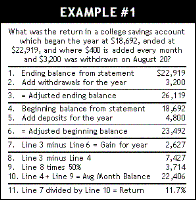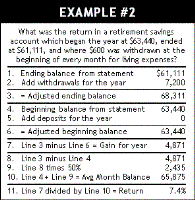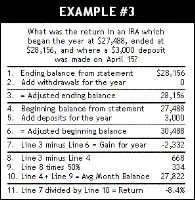How to Calculate Your Rate of Return for 2003

Part of a steward's job is making the most of the resources they are entrusted with. In the parable of the Talents, the stewards who invested their master's money well were commended, while the steward who didn't invest well was called lazy and wicked. How did your investments perform last year? If you're not sure, here's an easy way to calculate the approximate rate of return in any investment account. It won't be exact because we're giving up a little accuracy in return for simplicity — we're making the assumption that all deposit and withdrawal transactions take place at mid-year. This method will get you within one percent of the true return. That's close enough to provide a reality check.
Financial institutions provide account statements which include the data you'll need to perform the calculations. Get your beginning balance from the January 2003 statement, and your ending balance from the recent year-end statement. You'll also need to add up all the deposits and withdrawals you made during the year. (Treat any dividends or interest checks you may have received as withdrawals.)



When comparing your investment returns to those of published benchmarks like the Dow Industrials (up 25% in 2003) or the S&P 500 (up 26%), remember that they assume the amount invested is unchanged throughout the year. If you're dollar-cost-averaging, it's unlikely your results will be similar. Because you weren't fully invested for the entire period, you'll tend to do better than the averages in a down year and worse than the averages in an up year.
If the performance of your stock investments wasn't within a few percentage points of the market's return (reflected by the indexes above), the good news is that improvement doesn't have to be particularly difficult. One simple adjustment might be to start using index funds for the bulk of your stock investments — used properly, they're sure to provide results very similar to that of the overall market. Or, if you're willing to put a little effort into keeping up with your investments throughout the year, our Sound Mind Investing Upgrading strategy has topped the market's return in each of the past five years — through both bull and bear markets. Our free information packet describes how it works and can help you determine if it's a good fit for your investing situation.
© Sound Mind Investing
Published since 1990, Sound Mind Investing is America's best-selling financial newsletter written from a biblical perspective. Visit the Sound Mind Investing website.
Originally published January 06, 2004.









